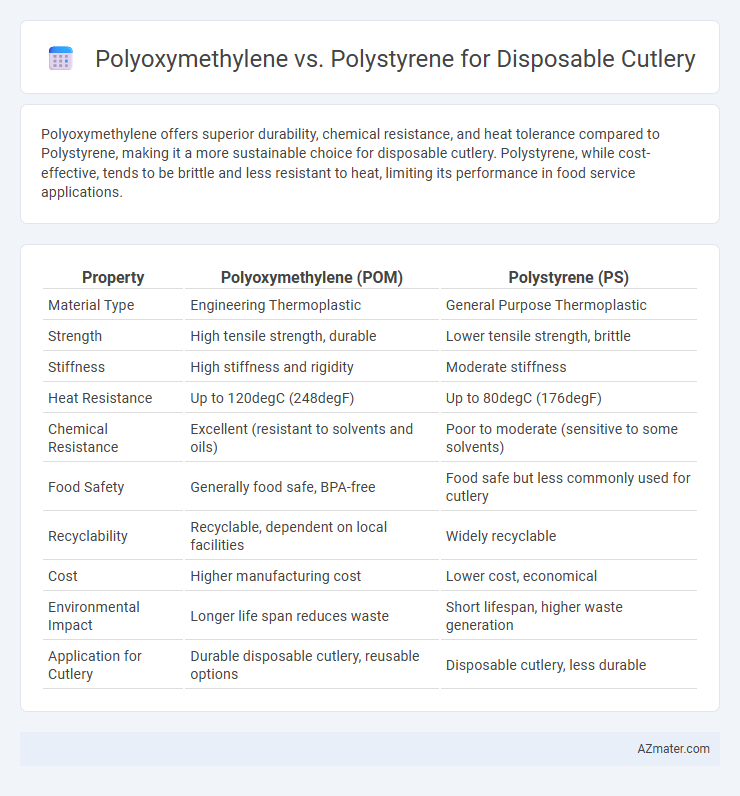Polyoxymethylene offers superior durability, chemical resistance, and heat tolerance compared to Polystyrene, making it a more sustainable choice for disposable cutlery. Polystyrene, while cost-effective, tends to be brittle and less resistant to heat, limiting its performance in food service applications.
Table of Comparison
| Property | Polyoxymethylene (POM) | Polystyrene (PS) |
|---|---|---|
| Material Type | Engineering Thermoplastic | General Purpose Thermoplastic |
| Strength | High tensile strength, durable | Lower tensile strength, brittle |
| Stiffness | High stiffness and rigidity | Moderate stiffness |
| Heat Resistance | Up to 120degC (248degF) | Up to 80degC (176degF) |
| Chemical Resistance | Excellent (resistant to solvents and oils) | Poor to moderate (sensitive to some solvents) |
| Food Safety | Generally food safe, BPA-free | Food safe but less commonly used for cutlery |
| Recyclability | Recyclable, dependent on local facilities | Widely recyclable |
| Cost | Higher manufacturing cost | Lower cost, economical |
| Environmental Impact | Longer life span reduces waste | Short lifespan, higher waste generation |
| Application for Cutlery | Durable disposable cutlery, reusable options | Disposable cutlery, less durable |
Introduction to Polyoxymethylene and Polystyrene
Polyoxymethylene (POM), known for its high stiffness, low friction, and excellent dimensional stability, offers durability and resistance to wear ideal for disposable cutlery requiring strength and precision. Polystyrene (PS) provides a cost-effective, lightweight, and easily moldable option with good clarity and rigidity, commonly used for disposable utensils prioritizing affordability and convenience. The choice between POM and PS hinges on balancing mechanical performance with production cost and environmental considerations in single-use cutlery applications.
Material Composition and Properties
Polyoxymethylene (POM) is an engineering thermoplastic known for its high stiffness, low friction, and excellent dimensional stability, making it suitable for durable disposable cutlery. Polystyrene (PS) is a lightweight, rigid polymer with good clarity but lower impact resistance and heat tolerance compared to POM. The material composition of POM, consisting of repeating formaldehyde units, provides superior mechanical strength and chemical resistance, whereas polystyrene's styrene monomers result in a more brittle and less heat-resistant product.
Mechanical Strength and Durability
Polyoxymethylene (POM) exhibits higher mechanical strength and superior durability compared to polystyrene (PS), making it more suitable for disposable cutlery requiring rigidity and impact resistance. POM's tensile strength ranges from 60 to 70 MPa, while PS typically offers around 45 MPa, contributing to better performance under stress. Moreover, POM resists abrasion and fatigue better than PS, ensuring enhanced longevity during use.
Heat Resistance and Thermal Stability
Polyoxymethylene (POM) exhibits superior heat resistance and thermal stability compared to Polystyrene (PS), making it more suitable for disposable cutlery exposed to higher temperatures. POM maintains its mechanical integrity at temperatures up to 120degC, whereas PS tends to soften and deform around 90degC. This thermal advantage ensures POM cutlery performs better during hot food use and sterilization processes.
Food Safety and Chemical Resistance
Polyoxymethylene (POM) offers superior chemical resistance and durability compared to polystyrene (PS), making it a safer choice for disposable cutlery in contact with various food types and acidic or oily substances. POM's low moisture absorption and resistance to food-grade chemicals reduce the risk of contamination and degradation during use. In contrast, polystyrene may leach styrene monomers and is more prone to cracking and chemical breakdown, raising food safety concerns for prolonged or heated food exposure.
Environmental Impact and Biodegradability
Polyoxymethylene (POM) is a highly durable plastic with limited biodegradability, resulting in long-term environmental persistence when used for disposable cutlery. Polystyrene (PS) also exhibits poor biodegradability and can contribute to significant marine and terrestrial pollution due to its lightweight nature and tendency to fragment into microplastics. Both materials pose substantial environmental challenges, but polystyrene's widespread use and slow degradation in natural environments intensify its ecological footprint compared to polyoxymethylene.
Cost-Effectiveness and Manufacturing Efficiency
Polyoxymethylene (POM) offers superior dimensional stability and wear resistance, leading to less waste and lower production costs in disposable cutlery manufacturing compared to polystyrene (PS), which is cheaper but more brittle and prone to breaking. POM's higher melt strength and thermal stability enable faster injection molding cycles and reduced scrap rates, enhancing manufacturing efficiency despite its higher raw material price. Polystyrene remains cost-effective for low-budget projects but results in increased breakage and product inconsistency, increasing overall expenses in mass production.
User Experience and Comfort
Polyoxymethylene (POM) offers superior durability and a smooth, lightweight feel that enhances user comfort in disposable cutlery, resisting deformation and maintaining structural integrity during use. Polystyrene (PS), while cost-effective and rigid, often feels brittle and less comfortable due to its tendency to snap or splinter under pressure, compromising the overall user experience. POM's resistance to heat and chemical exposure also ensures safer handling of hot or oily foods, making it a preferred material for disposable utensils where comfort and reliability are critical.
Regulatory Compliance and Standards
Polyoxymethylene (POM) meets stringent FDA and EU food contact regulations due to its high chemical resistance and stability, making it suitable for disposable cutlery. Polystyrene (PS), while widely accepted for single-use applications, often faces restrictions related to its brittleness and potential styrene migration under heat. Compliance with standards such as FDA 21 CFR 177.2470 for POM and FDA 21 CFR 177.1640 for PS ensures safety and performance in disposable cutlery manufacturing.
Conclusion: Choosing the Optimal Material for Disposable Cutlery
Polyoxymethylene (POM) offers superior mechanical strength, chemical resistance, and thermal stability compared to polystyrene (PS), making it more durable and reliable for disposable cutlery applications. Polystyrene, while more cost-effective and lightweight, tends to be brittle and less resistant to heat, potentially leading to breakage during use. Selecting POM ensures enhanced performance and user experience despite higher material costs, whereas PS suits budget-conscious, low-stress applications.

Infographic: Polyoxymethylene vs Polystyrene for Disposable cutlery
 azmater.com
azmater.com